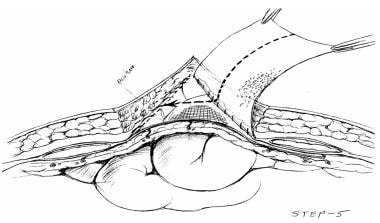Wittmann Patch Abdominal Closure
I have a physician who did a laparotomy w/repair of a ruptured aortic aneurysm (35092). A couple of days later, he reopened the incision (49002) and placed a Wittmann patch and a wound vac (97605). On 4 separate occasions after that, he opened the patch, inspected the abdominal cavity, performed lavage, closed the patch and reapplied the wound vac (97605). Can we bill for a reopening of a recent laparotomy each time he opens the patch and lavages? If so, would the correct coding be 49002-58-52? Download eragon 2 torrents.

At the fifth and last session, he removed the patch, closed the fascial layer, left the subq layer open and reapplied the wound vac (97605) Could you please suggest how to code for this? Hi, It's hard to tell without the actual op notes. However, if they are actually going into the abdominal cavity for lavage that is more than just changing a VAC dressing. We would code 49002 (M58, M52). We use M58 to indicate that it is a staged procedure, and M52 to show reduced service (since they do not have to re-OPEN the abdomen in these cases). We never code the VAC dressing when there is a definitive surgical procedure; just as you would not code the suturing of a surgical wound.
It is the method of closure (albeit temporary). If they change the dressing, maybe taking a quick look at status of wound healing, then we code 97605 (Negative pressure wound therapy (eg, vacuum assisted drainage collection), utilizing durable medical equipment (DME), including topical application(s), wound assessment, and instruction(s) for ongoing care, per session; total wound(s) surface area less than or equal to 50 square centimeters). Please check your documentation once before coding. Also, please refer to the following link for further clarification. Hope that helps. Related Topics.
CLOSURE OF LARGE ABDOMINAL WOUNDS THROUGH STEADY PRESSURE. The DRS and Wittmann patch systems supply sufficient closure force.
Abstract domen ” has likely contributed to im-proved outcomes in trauma patients, the challenge of subsequent fascial closure has emerged. Since mid 2004, we have incor-porated Wittmann Patch staged abdomi-nal closure into our management of the open abdomen. The purpose of this study was to evaluate the impact of this device on our incidence of fascial closure versus planned ventral hernia.
Methods: Patients managed by open abdomen from 2001 through 2006 were identified from the trauma registry. Fas-cial closure immediately after definitive repair of injuries was defined as “early fascial closure. ” Continuation of the open abdomen beyond the definitive repair of injuries with subsequent fascial closure was defined as “delayed fascial closure.” Since April 2004, the Wittmann Patch was uniformly employed in open abdo-men management. Patients managed be-fore the use of this device (“pre-Patch”) were compared with those managed in the “Patch ” era. Results: Fifty-six open abdomens were managed in the pre-Patch era and 103 were managed in the Patch era.

In the pre-Patch era, 33 (59%) underwent early fascial closure, compared with 67 (65%) in the Patch era (p NS). For the remaining patients, the incidence of delayed fascial closure was significantly higher in those managed with the Wittmann Patch com-pared with those managed in the pre-Patch era (78% vs.